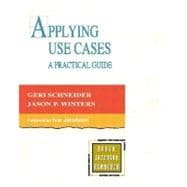
What is included with this book?
Geri Schneider is a senior consultant and trainer at Andrews Technology, Inc., in the areas of iterative development, software project management, object-oriented analysis and design, software architecture, design patterns, and use cases. In addition, she teaches in the software engineering management certificate program for the University of California Santa Cruz Extension. She previously worked for Rational Software Corporation mentoring customers in the areas of iterative development, object technologies, and use case analysis. Jason P. Winters is a staff design engineer for Cadence Design Systems, Inc. He was previously with Lucent Technologies as a staff engineer. At Lucent, he designed and built specialized tools, promoted the use of modern software development practices and tools throughout the company, and mentored projects on object-oriented analysis and design, UML, and use cases.
0201708531AB04062001
| Foreword | xi | ||||
| Preface to Second Edition | xiii | ||||
| Preface | xv | ||||
|
1 | (10) | |||
|
2 | (1) | |||
|
3 | (1) | |||
|
4 | (2) | |||
|
6 | (4) | |||
|
10 | (1) | |||
|
11 | (16) | |||
|
12 | (2) | |||
|
14 | (3) | |||
|
17 | (4) | |||
|
21 | (1) | |||
|
22 | (1) | |||
|
23 | (1) | |||
|
24 | (3) | |||
|
27 | (24) | |||
|
27 | (4) | |||
|
28 | (1) | |||
|
29 | (2) | |||
|
31 | (1) | |||
|
32 | (2) | |||
|
34 | (1) | |||
|
34 | (1) | |||
|
35 | (2) | |||
|
37 | (3) | |||
|
40 | (2) | |||
|
42 | (5) | |||
|
47 | (1) | |||
|
47 | (1) | |||
|
48 | (3) | |||
|
51 | (16) | |||
|
51 | (2) | |||
|
53 | (5) | |||
|
58 | (1) | |||
|
59 | (6) | |||
|
65 | (2) | |||
|
67 | (12) | |||
|
67 | (6) | |||
|
73 | (2) | |||
|
75 | (2) | |||
|
77 | (2) | |||
|
79 | (10) | |||
|
79 | (5) | |||
|
84 | (1) | |||
|
85 | (2) | |||
|
87 | (2) | |||
|
89 | (12) | |||
|
89 | (2) | |||
|
91 | (3) | |||
|
94 | (1) | |||
|
95 | (3) | |||
|
98 | (1) | |||
|
99 | (2) | |||
|
101 | (22) | |||
|
101 | (2) | |||
|
103 | (1) | |||
|
103 | (1) | |||
|
104 | (1) | |||
|
104 | (1) | |||
|
104 | (1) | |||
|
105 | (2) | |||
|
107 | (15) | |||
|
107 | (1) | |||
|
108 | (4) | |||
|
112 | (3) | |||
|
115 | (5) | |||
|
120 | (2) | |||
|
122 | (1) | |||
|
123 | (20) | |||
|
123 | (6) | |||
|
124 | (1) | |||
|
125 | (1) | |||
|
126 | (1) | |||
|
126 | (3) | |||
|
129 | (4) | |||
|
133 | (1) | |||
|
133 | (3) | |||
|
136 | (4) | |||
|
140 | (1) | |||
|
141 | (1) | |||
|
142 | (1) | |||
|
143 | (16) | |||
|
143 | (8) | |||
|
149 | (1) | |||
|
150 | (1) | |||
|
151 | (7) | |||
|
151 | (1) | |||
|
152 | (1) | |||
|
153 | (4) | |||
|
157 | (1) | |||
|
157 | (1) | |||
|
158 | (1) | |||
|
159 | (12) | |||
|
159 | (7) | |||
|
160 | (1) | |||
|
161 | (2) | |||
|
163 | (1) | |||
|
164 | (2) | |||
|
166 | (1) | |||
|
167 | (2) | |||
|
168 | (1) | |||
|
168 | (1) | |||
|
168 | (1) | |||
|
169 | (1) | |||
|
170 | (1) | |||
| Appendix A Resources | 171 | (4) | |||
| Appendix B Documentation Templates | 175 | (4) | |||
|
175 | (1) | |||
|
176 | (3) | |||
| Appendix C UML Notation | 179 | (6) | |||
| Appendix D Sending Results of the Use Case Estimator | 185 | (2) | |||
| Appendix E Order-Processing System | 187 | (52) | |||
|
188 | (1) | |||
|
188 | (1) | |||
|
189 | (1) | |||
|
190 | (49) | |||
| Index | 239 |
The New copy of this book will include any supplemental materials advertised. Please check the title of the book to determine if it should include any access cards, study guides, lab manuals, CDs, etc.
The Used, Rental and eBook copies of this book are not guaranteed to include any supplemental materials. Typically, only the book itself is included. This is true even if the title states it includes any access cards, study guides, lab manuals, CDs, etc.